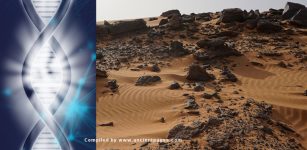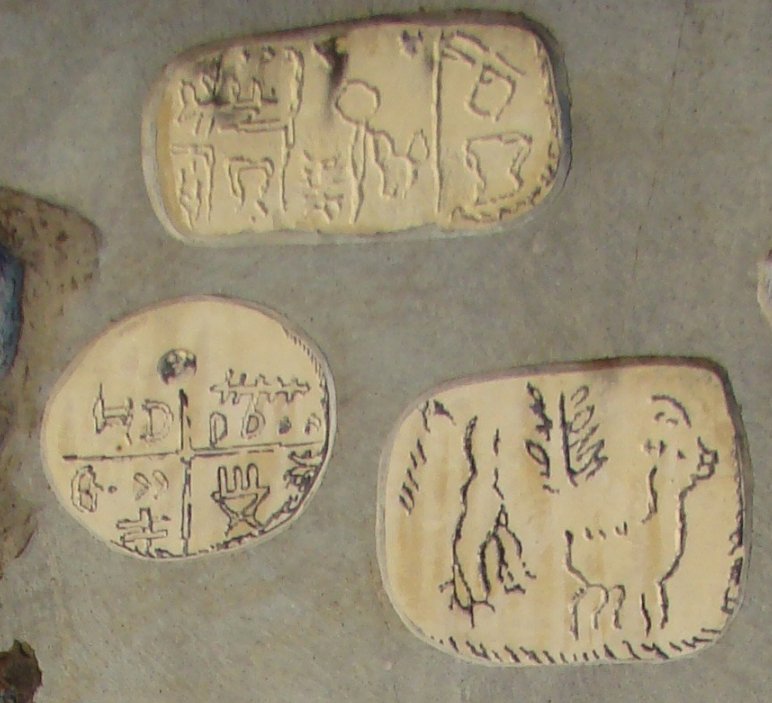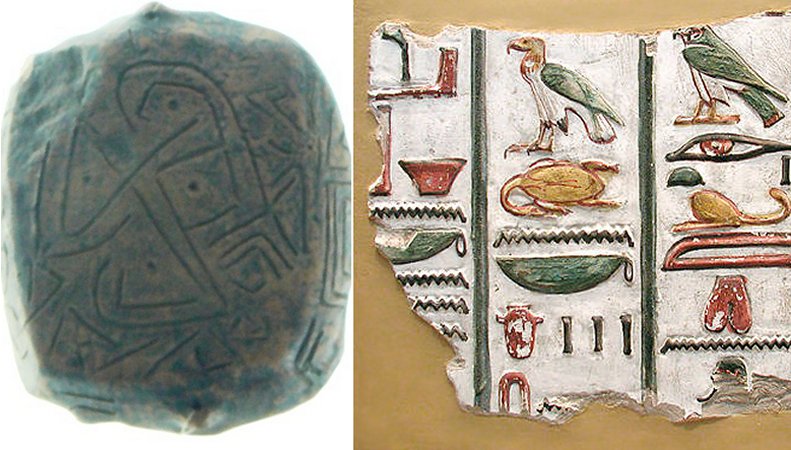Script On Gradeshnitsa Tablets May Pre-Date Egyptian Hieroglyphs
Ellen Lloyd - AncientPages.com - Can the nearly 7,000-year-old Gradeshnitsa Tablets offer evidence of one of the world's oldest human writing? Are the carved signs and symbols on the tablets merely decorations or an unknown ancient language?
Monument for the Neolithic Tărtăria tablets , dated to 5500-5300 BC and discovered in 1961 at Tărtăria , Alba County, Romania by the archaeologist Nicolae Vlassa . The clay tables are associated with the Turdaş-Vinča culture and the Vinča symbols on them predate the proto- Sumerian pictographic script. The monument has been created near the discovery location. Monument near the site. Translation of the inscription: Tărtăria 5500 BC: The first written message in human history. Image credit: Țetcu Mircea Rareș - CC BY-SA 3.0
Those who examined the Gradeshnitsa tablets concluded the engravings were identical to the hieroglyphic script found on ancient Egyptian tablets and pyramid texts.
The most controversial theory suggests the Gradeshnitsa tablets from Old Europe predate Egyptian hieroglyphs by at least two millennia! Did ancient Egyptian inherit the knowledge of hieroglyphs from ancient European civilizations?
Similarities Between The Gradeshnitsa tablets And Tartaria Tablets
The Gradeshnitsa tablets, dated around 5,000 BC, were unearthed in 1969 near the village of Gradeshnitsa in the Vratsa Province of northwestern Bulgaria. The inscribed tablets are striking, similar to the signs on the controversial Tartaria tablets.
As discussed previously on Ancient Pages, the Tartaria tablets discovered in Romania are "covered with pictographic writing are extraordinary because they raise the possibility that writing in the Danube basin predated the earliest Sumerian cuneiform and Egyptian hieroglyphics."'
Left: A copy of the backside of the Gradeshnitsa tablet, exhibited in the Vratsa History Museum. Credit: Vassia Atanassova - Spiritia - Right: Hieroglyphs from the tomb of Seti I. Credit: Jon Bodsworth, Public Domain
Was a very similar language used by ancient people who lived in Bulgaria at the same time?
Some 7,000 years ago, the sophisticated Chalcolithic civilization of Southeast Europe left a legacy that is largely forgotten today. Though they lived a nomadic lifestyle, these people possessed good metallurgical technology knowledge and left behind some remarkable ancient artifacts offering evidence of their skills.
According to scientists, the Chalcolithic civilization of Southeast Europe was connected with people living in other parts of the continent and the rest of the Old World. Studies of different kinds of pottery scattered throughout the region reveal extensive trading and interaction between these ancient people.
The unified Chalcolithic cultures can be traced back to the beginning of the Neolithic. The civilization was divided into various centers, and people built small villages and settlements.
In time the cultures expanded, and their settlements grew in size and number. Today, the mysterious Vinca culture, famous for creating outstanding figurines and script scholars still struggle to decipher, flourished from 6000 BC to 3000 BC on the banks of the Danube river.
The Vinca was by no means a primitive ancient culture. Some of the largest Vinca sites in the 5th millennium were larger than those of Minoan and Mycenaean.
Did Ancient Egyptians inherit Knowledge Of The Hieroglyphs From Old Europe?
Excavations at ancient sites have provided us with historical information about the fascinating Chalcolithic civilization of Southeast Europe. Near Provadiya and Varna in Northeast Bulgaria, we can find Provadiya – Solnitsata ("The Salt Pit") Settlement Mound. This salt pit mound appears to have been Europe's oldest town. Putting their settlements and daily life aside, the most intriguing aspect of these cultures revolves around their languages and scripts.
Little is known about the Gradeshnitsa tablets currently preserved in the Vratsa Archeological Museum of Bulgaria, and scholars cannot determine if they offer evidence of old writing.
Is it possible the script on the Gradeshnitsa tablets is older than the Egyptian Hieroglyphs? Credit: The Institute of Transcendent Science
Steven Roger Fischer, former director of the Institute of Polynesian Languages and Literatures in Auckland, New Zealand "the current opinion is that these earliest Balkan symbols appear to comprise a decorative or emblematic inventory with no immediate relation to articulate speech."
According to the Institute of Transcendent Science, examinations of the Gradeshnitsa tablets reveal something intriguing. Studies show the script found on the Gradeshnitsa tablets is an Early-Thracian version of this hieroglyphic script we have discovered in Egypt.
The Institute of Transcendent Science states, "the Script used in the engravings upon the Tablet of Gradeshnitsa, found in the land of Ancient Thrace (present-day Bulgaria) and the Scripts used in similar tablets and the pyramid texts, found in Ancient Egypt, represent one and the same hieroglyphic script."
It has led scholars to speculate that ancient Egyptians may not have been the first to use hieroglyphs. This finding suggests that hieroglyphic script originated from ancient Thracians, present-day Bulgaria. This writing knowledge could have been transferred and introduced in ancient Egypt.
Ancient Pages wrote earlier that "more and more evidence confirms a very brave thesis, that the Balkan Peninsula, rather than ancient Mesopotamia, is the cradle of our civilization.
The evidence of a little-known culture preceding Egyptian and even Sumerian culture has been attracting the attention of researchers, turning everything we know about antiquity upside down."
What if the cradle of civilization should be sought in Old Europe and not Mesopotamia?
Written by Ellen Lloyd – AncientPages.com
Updated on March 7, 2023
Copyright © AncientPages.com All rights reserved. This material may not be published, broadcast, rewritten or redistributed in whole or part without the express written permission of AncientPages.com
Expand for referencesMore From Ancient Pages
-
 Tullus Hostilius: Warrior King Of Rome, Who Succeeded Numa Pompilius And Feared Prophecies
Featured Stories | Mar 6, 2019
Tullus Hostilius: Warrior King Of Rome, Who Succeeded Numa Pompilius And Feared Prophecies
Featured Stories | Mar 6, 2019 -
 Charlemagne – Most Famous Emperor Of Education And Enemy Of Pagan Worshippers – What Did He Really Mean For Europe?
Featured Stories | Mar 22, 2023
Charlemagne – Most Famous Emperor Of Education And Enemy Of Pagan Worshippers – What Did He Really Mean For Europe?
Featured Stories | Mar 22, 2023 -
 Germany’s Stonehenge Pömmelte Reveals More Secrets – 140 Wooden Houses And 78 Silos Found
Archaeology | Jul 2, 2024
Germany’s Stonehenge Pömmelte Reveals More Secrets – 140 Wooden Houses And 78 Silos Found
Archaeology | Jul 2, 2024 -
 Scientists In Antarctica Encounter Something Very Strange
Featured Stories | Mar 9, 2020
Scientists In Antarctica Encounter Something Very Strange
Featured Stories | Mar 9, 2020 -
 Trajan’s Column – A Roman Triumphal Column In Ancient Rome
Ancient History Facts | Aug 31, 2021
Trajan’s Column – A Roman Triumphal Column In Ancient Rome
Ancient History Facts | Aug 31, 2021 -
 Unsolved Mystery Of Gedi Ruins Protected By The ‘Old Ones’ – Why Did People Leave?
Civilizations | Apr 2, 2019
Unsolved Mystery Of Gedi Ruins Protected By The ‘Old Ones’ – Why Did People Leave?
Civilizations | Apr 2, 2019 -
 2,000-Year-Old Ruins In Mary Magdalene’s Town Of Magdala On The Shore Of The Sea Of Galilee
Biblical Mysteries | Dec 26, 2014
2,000-Year-Old Ruins In Mary Magdalene’s Town Of Magdala On The Shore Of The Sea Of Galilee
Biblical Mysteries | Dec 26, 2014 -
 Mystery Of Viking Ship Burials In Hjarnø, Denmark And Their Unusual Design
Archaeology | Jun 1, 2021
Mystery Of Viking Ship Burials In Hjarnø, Denmark And Their Unusual Design
Archaeology | Jun 1, 2021 -
 Amazing Discovery: Great Pyramid Of Giza And Its Chambers Concentrate Electromagnetic Energy
Archaeology | Jul 31, 2018
Amazing Discovery: Great Pyramid Of Giza And Its Chambers Concentrate Electromagnetic Energy
Archaeology | Jul 31, 2018 -
 Real Giant Kojomkul Who Became A Folk Hero In Kyrgyzstan
Featured Stories | Dec 2, 2020
Real Giant Kojomkul Who Became A Folk Hero In Kyrgyzstan
Featured Stories | Dec 2, 2020 -
 On This Day In History: First Experimental Hydrogen-Filled Balloon Reaches A 900m Altitude – On August 27, 1783
News | Aug 27, 2016
On This Day In History: First Experimental Hydrogen-Filled Balloon Reaches A 900m Altitude – On August 27, 1783
News | Aug 27, 2016 -
 ‘Yunatsite’ And Thought-Provoking Theory That Balkan Peninsula And Not Mesopotamia Was The Cradle Of Civilization
Civilizations | Jan 14, 2023
‘Yunatsite’ And Thought-Provoking Theory That Balkan Peninsula And Not Mesopotamia Was The Cradle Of Civilization
Civilizations | Jan 14, 2023 -
 Mystery In The Stones: Rujm El-Hiri (Wheel Of Ghosts) Was Not An Ancient Observatory – So Why Was It Built? – New Study
Archaeology | Jan 2, 2025
Mystery In The Stones: Rujm El-Hiri (Wheel Of Ghosts) Was Not An Ancient Observatory – So Why Was It Built? – New Study
Archaeology | Jan 2, 2025 -
 Tombstone With Ancient Greek Inscription Unearthed Near Nitzana In The Negev, Israel
Archaeology | Jan 8, 2021
Tombstone With Ancient Greek Inscription Unearthed Near Nitzana In The Negev, Israel
Archaeology | Jan 8, 2021 -
 ‘Georgia Guidestones’: Bizarre Ominous And Strange Monument In North America
Featured Stories | Mar 27, 2022
‘Georgia Guidestones’: Bizarre Ominous And Strange Monument In North America
Featured Stories | Mar 27, 2022 -
 Evidence The Khufu Channel Aided The Construction Of The Giza Pyramids Found – Scientists Say
Archaeology | Aug 31, 2022
Evidence The Khufu Channel Aided The Construction Of The Giza Pyramids Found – Scientists Say
Archaeology | Aug 31, 2022 -
 Humans Got To America 7,000 Years Earlier Than Thought – New Research Confirms
Archaeology | Oct 9, 2023
Humans Got To America 7,000 Years Earlier Than Thought – New Research Confirms
Archaeology | Oct 9, 2023 -
 Is Legendary Norumbega In North America A Lost Viking Settlement?
Featured Stories | Jan 8, 2021
Is Legendary Norumbega In North America A Lost Viking Settlement?
Featured Stories | Jan 8, 2021 -
 Visit The Palace Where Alexander The Great Was Born In Pella
Archaeology | Oct 21, 2020
Visit The Palace Where Alexander The Great Was Born In Pella
Archaeology | Oct 21, 2020 -
 Ancestral Home Of All Humans Revealed Through World’s Largest Genome Reconstruction Of Our Ancestors
Archaeology | Jan 3, 2023
Ancestral Home Of All Humans Revealed Through World’s Largest Genome Reconstruction Of Our Ancestors
Archaeology | Jan 3, 2023



